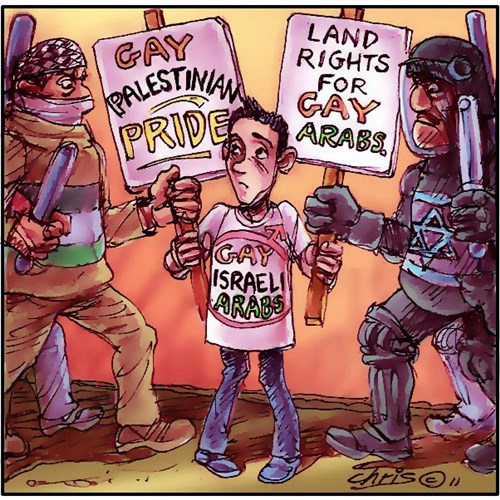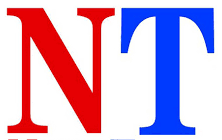
Israeli democracy, through its promotion of lesbian, gay, bisexual, and transgender (LGBT) rights, offers golden handcuffs—a beautiful gift that comes with control—to Israeli queers. At a lecture in Tel Aviv at the Women’s Peace Coalition, I heard the strain in the voices of queer Israeli activists who are chafing under Israel’s progressive gay rights record. One activist stated, “Apparently, we have won all our rights. It is as if we should be grateful and keep silent about the injustices of the occupation. LGBT rights in Israel are conditional rights; we cannot openly support the Boycotts, Divestment, and Sanctions (BDS) movement without legal repercussions.” (See, for example, an article on the “Boycott Bill” in The Jerusalem Post.
That is right. Progressive Israeli queer organizing has now been criminalized if it in any way supports the BDS movement. How is that for irony? These activists also report that transgender and gender-non-confirming queers were not welcome in this new version of the proper “homonationalist” Israeli citizen. Sexual “liberation” for the privileged few comes in exchange for limits on political freedom for all.
More specifically, in terms of Palestinian queers, the LGBT rights project itself relies on the impossibility and non-recognition of a proper Palestinian queer subject, except for within the purview of the Israeli state itself. As a lawyer at the Palestinian human rights organization Adalah explained to us, LGBT laws in Israel are liberal because they are considered to be an “internal” affair. Yet, the ironies proliferate. On 11 January, on the same day Tel Aviv’s dubious honor as the “world’s best gay city” was announced, an amendment to Israel’s citizenship laws that prohibits the unification of West Bank Palestinians with their spouses in Israel was upheld by the High Court of Justice. Additionally, “social suitability” laws were passed, and the regulation of sexual activities between foreign laborers and Israeli Jews was attempted. From all this legal activity, it becomes patently clear that LGBT liberation also works to distract attention from intense forms of (hetero)sexual regulation. Such regulation ultimately seeks to constrict the sexual and familial activities of all bodies not deemed suitable for the Israeli body politic.
Golden handcuffs essentially limit the resistance of gay Israeli citizens benefiting the most directly from legal and cultural forms of sexual freedom. The trade off of freedom for suppression is even more complex for Palestinians living in Israel. But what of the queer Palestinians living under occupation? If Israel is so convinced of the grandeur of gay Tel Aviv, perhaps it should make it possible for queer Palestinians to actually reach this beacon of modernity and freedom?
Pinkwashing only makes sense through an erasure of the spatial logics of occupational control as an intricate, even intimate system of apartheid emerges. This system is replete with a dizzying array of locational obstacles to Palestinian mobility. That queer Palestinian activists in Ramallah cannot travel to Haifa, Jersusalem or Gaza to meet fellow Palestinian activists seems to be one of the most obvious ways the Israeli occupation delimits—no, prohibits– the possibilities for queer communities and organizing to flourish among Palestinians. The antithesis of what Israeli gays enjoy without hassle.
Unfortunately, instead of understanding access to mobility and congregation as constitutive of queer identity and community, pinkwashing reinforces ideologies of the clash of cultures. They reinforce the “cultural difference” of Palestinian homophobia rather than recognize the constraining, suffocating spatial and economic effects of Israeli occupation. Queer Palestinians are no more mobile than other Palestinians. The golden handcuffs are more like the concrete and steel of the walls and roads of spatial apartheid for them.
During our seven-day lesbian, gay, bisexual, transgender, intersexed, and questioning (LGBTIQ) delegation, the first of its kind to the West Bank, we were part of countless discussions about various travel routes. How many and what kinds of checkpoints would be encountered on a chosen route? How easy or difficult would they be to traverse? What kinds of delays could be anticipated? Our delegation of visiting US citizens experienced the bodily and logistical discombobulation of always needing to be hyperaware of how one is transiting through ever-shifting boundaries between Israel and the West Bank.
Questions about the treatment of homosexuals in the West Bank or the Gaza Strip fail to take into account the constant and omnipresent restrictions on mobility, contact, and organizing necessary to build any kind of queer presence and politics. What becomes clear is that the purported concern for the status of homosexuals in the West Bank and Gaza is being used to shield Israeli occupation from direct culpability in suppressing, indeed endangering, those very homosexuals.
For the constrained, yet thriving, political platform of Palestinian Queers for BDS, Al-Qaws for Sexual and Gender Diversity in Palestinian Society, and Aswat, queer organizing is anti-occupation organizing. Likewise, anti-occupation work is queer organizing. Palestinian Queers for BDS members point out that it is irrelevant whether Palestinian society is homophobic or not. The question of homophobia within Palestinian society has nothing to do with the fact that Israeli occupation must end. The occupation is, in this context, quite simply a queer issue. Al-Qaws makes it clear that its primary work is about ending the occupation, not about reifying a homosexual identity that mirrors an “Israeli” or “Western” self-serving form of sexual freedom. We might do well, then, to realize that pinkwashing is what Michel Foucault called an “incitement to discourse”: a call and response circuit that produces an identity that is purportedly not there.
Refusing the liberal response to this incitement to discourse—a contemporary version of “We are here; we are queer; get used to it”—Palestinian Queers for BDS thus challenges single-axis identity politics, while remaining fully aware of the trap of nationalism. Their organizing strategies suggest that one might not want to respond to pinkwashing primarily as queers, since such a response reinforces the logic of pinkwashing that isolates queer identities from other identities. Nor is pinkwashing a queer issue per se. Pinkwashing is thus not about sexual identity at all in this regard but rather a powerful manifestation of the regulation of identity in an increasingly homonationalist world. Such a world that evaluates nationhood on the basis of the treatment of its homosexuals and works to justify the occupation.
The challenge, then, for Palestinian Queers for BDS, and for those of us who are progressive activists—queer or not—is to not allow the liberal or establishment gays in Europe and America (who are the primary target of pinkwashing) to redirect the script of anti-pinkwashing activism away from this radical approach. Failing this, as Maya Mikdashi has so brilliantly articulated, the rewriting of a radical Palestinian queer politics by a liberal Euro-American queer politics would indeed be a further entrenchment of homonationalism.
Pinkwashing has become a commonly used tag for the cynical promotion of LGBT bodies as representative of Israeli democracy. As its use as a shorthand proliferates, it must be situated within its wider geopolitical context. That is to say, pinkwashing works because both history and global international relations matter. So while it is crucial to challenge the Israeli state, it must be done in a manner that acknowledges the range of complicit actors. Building on theoretical points first articulated in my 2007 book, Terrorist Assemblages, I contend it is crucial to keep in mind that pinkwashing works because of (at least) the following six reasons.
1. The history of settler colonial violence that has used the figures of women and children (the woman question), and now the homosexual, to obfuscate its violence. Pinkwashing is only one more justification for imperial racial and national violence that has a long history preceding it.
2. The proliferation of global Islamophobia engendered by the war on terror (as well as forms of Islamophobia that pre-date 11 September 2001).
3. A neoliberal accommodationist economic structure engenders the niche marketing of various ethnic and minoritized groups, thereby normalizing the production of a gay and lesbian tourism industry built on the discursive distinction between gay friendly and not gay-friendly destinations.
4. The gay and lesbian human rights industry, which continues to proliferate Euro-American constructs of identity (not to mention the notion of a sexual identity itself), privileges identity politics, including “coming out”, public visibility, and legislative measures, to be the dominant barometers of social progress,
5. The homonationalist history of Israel or the rise of LGBT rights in Israel that parallels the concomitant increasing segregation of Palestinian populations, especially in the post-Oslo period.
6. The financial, military, affective, and ideological entwinement of US and Israeli settler colonialisms is relevant to pinkwashing. The United States and Israel are the largest benefactors of homonationalism, as it operates on three scalar registers: internal, territorial, and global. Moreover, pinkwashing is to a large extent directed towards the United States, Israel’s greatest financial supporter internationally, and more generally to Euro-American gays who have the political capital and financial resources to invest in Israel.
Some might say that golden handcuffs and other forms of control and trade-offs for rights for some over the rights of others can also work within Palestinian resistance. But let me tell you why homonationalism does not describe organizing under the BDS movement. I had the honor of meeting Omar Barghouti at a talk I gave at Birzeit University in Ramallah after the delegation ended. “I came to hear you and to understand more about homonationalism,” he told me. I mentioned that queer Israeli activists are wondering if Palestinian Queers for BDS is being “used” by the BDS movement in the same way that they are being used by pinkwashing. “Is the BDS movement embracing queer Palestinians?” he wanted to know. While Barghouti elaborated about the BDS movement dynamism, its short-term changes, and long-term vision, I marveled at the inadequacies of the questions raised.
What I learned on this delegation suggests that Palestinian Queers for BDS is not a liberal project that is demanding acceptance, tolerance or inclusion within a “nationalist” movement. Rather, by foregrounding the occupation as its primary site of struggle, Palestinian Queers for BDS is slowly, strategically, and carefully insisting upon and creating systemic and thorough changes in Palestinian society itself. Golden handcuffs—no matter how offered or how shiny—will simply not do.
[This article was originally published on The Feminist Wire.]
Tuesday, February 07, 2012 – 11:09:00 AM
